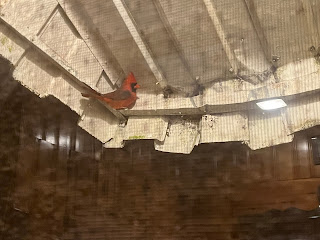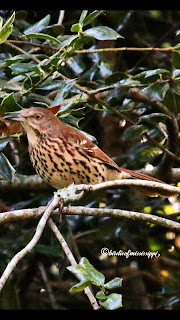ALMOST BUT NOT QUITE - 2/19/20
ALMOST BUT NOT QUITE
By PEGGY WILLIAMS AKA Birdie of Mississippi
I don’t know about you, but with many species of birds, I have a hard time being certain what type of bird that I have visiting my yard. If I am outside and I only get a “buzz by” of a bird that’s not a common visitor to my feeders I have to be pretty quick to notice their features that distinguish them. Many birds are automatically identified such as male northern cardinals, blue jays, and robins because those we are generally taught to recognize in elementary school, but many birds have only slight differences that can easily confuse a beginner “Birdie.”
Two birds that come to my mind are “downy and hairy” woodpeckers. Each of these woodpeckers have black and white feathers, stripes on their heads, polka dots on their wings and if they are males - a red patch of feathers on the back of their heads, but the major difference is their size. The downy is 6” and the hairy is 9” when means that one is considered a small bird and the other a medium size bird, but could “almost” be twins otherwise.
The purple finch and the house finch are also very similar and require a good examination to be certain that you are identifying them correctly. They are both small birds (5 – 6”), but it is their feather coloring and the stripes on their tummies that distinguish their looks. The purple finch is generally considered to have the more beautiful color. Roger Tory Peterson – author of The Peterson Field Guides - described it as “a sparrow dipped in raspberry juice,” and that really describes it perfectly! The house finch that looks similar to the purple finch has coloring that is more of a red color on the face and you will find brown stripes on its tummy that the purple finch doesn’t have.
Field Guides are a necessity for amateur and professional “Birdies” because even as an amateur you can enjoy the bird kingdom a lot more if you learn about the similarities and the differences of birds. These differences and similarities make each bird unique. Learning and the enjoyment of learning keeps our minds active and youthful!
Today I learned something new as I researched for this article about the house finch. There was a tip in The Gardener’s Bird Book by Tom Carpenter that said “One way to discourage house finches from hitting all your feeders is to provide some tube feeders with the feeding ports below rather than above the feeding perches. House finches have weak feet, and won’t be able to feed here; this will allow chickadees, goldfinches, nuthatches, siskins and other smaller natives to have a spot of their own.” I had to read this quote a couple of times and look at the photo in the book before I understood it. The other birds listed didn’t mind hanging upside down on the perch and eating because they didn’t have weak feet! Today I am ordering an “Upside Down Thistle Tube Feeder” so that I can watch them eat upside down! Since it hasn’t arrived see the attached drawing of what these tube feeders look like.
Continue to “Look at the birds of the air, for they neither sow nor reap nor gather into barns; yet your Heavenly Father feeds them…” (Matthew 6:26) and as you look, I pray that you will become a conservationist and an environmentalist as much as you can possibly be, so that we take care of all that God has given us.
My photos may be viewed & “LIKED” on Facebook, Instagram and Pinterest - “Birdie of Mississippi”.
E-mail: birdieofmississippi@gmail.com - Read my Blog @ http://www.birdieofmississippi.blogspot.com





Comments
Post a Comment